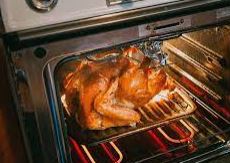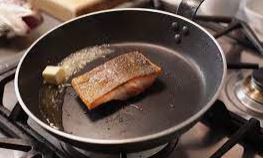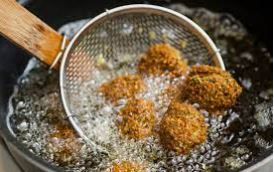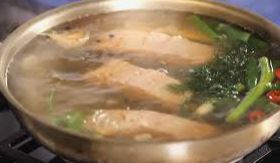Cookery Methods

Basic Cookery Methods
Choosing the Right Cooking Technique Using the appropriate cooking method for the type of food being prepared is a major part of the culinary arts. Tough cuts of meat need to be cooked slowly, at low heats, for a long time, and with plenty of moisture. Prepared properly, these tough cuts can become incredibly tender and delicious.
Basic cooking methods are divided into two main categories:
- Dry heat cooking - such as roasting, broiling or sautéing
- Moist heat cooking - like braising, steaming or poaching
Because every cooking method uses either dry heat or moist heat (or sometimes both), classifying them this way ensures that every known method falls into one category or the other. It is worth noting that cooking methods involving fat, such as sautéing and deep-frying, are considered dry-heat methods. If this seems confusing, remember that oil and water do not mix, so while fat can take a liquid form, in many ways it is the opposite of water — hence "dry" heat.

Dry heat cooking
Dry heat cooking refers to any cooking technique where the heat is transferred to the food item without using any moisture. Dry-heat cooking typically involves high heat, generally inside an oven and at temperatures of at least 150°C and often much hotter. Baking or roasting in an oven is a dry heat method because it uses hot air to conduct the heat. Pan-searing a steak is considered dry-heat cooking because the heat transfer takes place through the hot metal of the pan. Note that the browning of food can only be achieved through dry-heat cooking.Examples of dry-heat methods include:
- Roasting & Baking
 Roasting and baking are forms of dry-heat cooking that use hot, dry air to cook food uncovered as the dry air delivers the heat. Like other dry-heat cooking methods, roasting and baking brown the surface of the food, which in turn develops complex flavours and aromas. Because it uses indirect heat, baking and roasting food fairly evenly since all of the food's surfaces are exposed to the heat to the same extent. Others may prefer to use the word "roasting" specifically for meats, poultry and vegetables, but use the term "baking" for fish and other seafood.
Roasting and baking are forms of dry-heat cooking that use hot, dry air to cook food uncovered as the dry air delivers the heat. Like other dry-heat cooking methods, roasting and baking brown the surface of the food, which in turn develops complex flavours and aromas. Because it uses indirect heat, baking and roasting food fairly evenly since all of the food's surfaces are exposed to the heat to the same extent. Others may prefer to use the word "roasting" specifically for meats, poultry and vegetables, but use the term "baking" for fish and other seafood.
- Grilling & Broiling
 Grilling and broiling rely on heat being conducted through the air from an open flame. This type of cooking produces browning reactions on the surface of the food, thus encouraging the development of complex flavors and aromas. Because air is a poor conductor of heat, broiling and grilling require the food to be quite close to the heat source, which in this case is likely to be an open flame. There is one significant distinction between broiling and grilling, which is that grilling involves heating the food below, while broiling involves heating from above.
Grilling and broiling rely on heat being conducted through the air from an open flame. This type of cooking produces browning reactions on the surface of the food, thus encouraging the development of complex flavors and aromas. Because air is a poor conductor of heat, broiling and grilling require the food to be quite close to the heat source, which in this case is likely to be an open flame. There is one significant distinction between broiling and grilling, which is that grilling involves heating the food below, while broiling involves heating from above.
- Sautéing & Pan-Frying
 Sautéing uses a very hot pan and a small amount of fat to cook the food very quickly. Like other dry-heat cooking methods, sautéing browns the food surface as it cooks and develops complex flavours and aromas. When sautéing, it is important to heat the pan for a minute, then add a small amount of fat and let the fat get hot as well, before adding the food to the pan. This hot fat helps to brown the surface of the food and the pan must stay hot throughout the cooking process. Too much food in the pan dissipates the heat, causing the food to steam or boil rather than sauté.
Sautéing uses a very hot pan and a small amount of fat to cook the food very quickly. Like other dry-heat cooking methods, sautéing browns the food surface as it cooks and develops complex flavours and aromas. When sautéing, it is important to heat the pan for a minute, then add a small amount of fat and let the fat get hot as well, before adding the food to the pan. This hot fat helps to brown the surface of the food and the pan must stay hot throughout the cooking process. Too much food in the pan dissipates the heat, causing the food to steam or boil rather than sauté.
- Deep-Frying
 Since deep-frying involves submerging food in hot, liquid fat, it might take some time to get used to the idea that it is a form of dry-heat cooking. Even though fat can take a liquid form, it is considered a solid — thus dry heat. Food items to be fried are often dipped in a batter or coated in breadcrumbs to protect and further seal in their natural moisture. When deep-frying, keeping the oil hot is critical to producing a quality product. The key is to fry items in small batches because putting too much food in the oil all at once will lower the oil's temperature.
Since deep-frying involves submerging food in hot, liquid fat, it might take some time to get used to the idea that it is a form of dry-heat cooking. Even though fat can take a liquid form, it is considered a solid — thus dry heat. Food items to be fried are often dipped in a batter or coated in breadcrumbs to protect and further seal in their natural moisture. When deep-frying, keeping the oil hot is critical to producing a quality product. The key is to fry items in small batches because putting too much food in the oil all at once will lower the oil's temperature.

Moist heat cooking
Moist or Wet-heat cooking methods include any techniques that involve cooking with moisture — whether it is steam, water, stock, wine or some other liquid. Cooking temperatures are much lower, anywhere from 60°C to a maximum of 100°C, because water does not get any hotter than that.Examples of moist-heat cooking methods include:
- Poaching Cooking
 Cooking in liquid with a temperature ranging from 60°C to 80°C is called poaching and is typically reserved for cooking very delicate items like eggs and fish. Within this range of temperatures, the poaching liquid will not show any visible signs of bubbling at all, though small bubbles may form at the bottom of the pot. This means that the best way of checking that the temperature is correct is with a thermometer.
Cooking in liquid with a temperature ranging from 60°C to 80°C is called poaching and is typically reserved for cooking very delicate items like eggs and fish. Within this range of temperatures, the poaching liquid will not show any visible signs of bubbling at all, though small bubbles may form at the bottom of the pot. This means that the best way of checking that the temperature is correct is with a thermometer.
- Simmering
 With simmering, the cooking liquid is a bit hotter than poaching — from 80°C to 95°C. Here we will see bubbles forming and gently rising to the surface of the water, but the water still is not at a full rolling boil. It is an excellent choice for culinary preparations including stocks or soups, starchy items such as potatoes or pasta, and many others. One of the downsides to cooking this way is that it can cause the food to lose vitamins and other nutrients by leaching into the cooking liquid.
With simmering, the cooking liquid is a bit hotter than poaching — from 80°C to 95°C. Here we will see bubbles forming and gently rising to the surface of the water, but the water still is not at a full rolling boil. It is an excellent choice for culinary preparations including stocks or soups, starchy items such as potatoes or pasta, and many others. One of the downsides to cooking this way is that it can cause the food to lose vitamins and other nutrients by leaching into the cooking liquid.
- Boiling
 The hottest of these three stages is boiling, where the water reaches its highest possible temperature of 100°C. It is actually the least likely of the three to be used for cooking. That is because the violent agitation caused by the rolling boil can be too rough on food and will often damage it. Water at a full boil would be a bad choice for cooking an egg outside its shell, as we do when preparing poached eggs because the agitation would cause the egg to fall apart. The same holds true for delicate fish as well as some pasta
The hottest of these three stages is boiling, where the water reaches its highest possible temperature of 100°C. It is actually the least likely of the three to be used for cooking. That is because the violent agitation caused by the rolling boil can be too rough on food and will often damage it. Water at a full boil would be a bad choice for cooking an egg outside its shell, as we do when preparing poached eggs because the agitation would cause the egg to fall apart. The same holds true for delicate fish as well as some pasta
